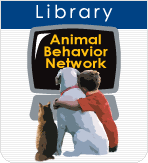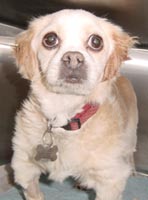|
Need Help? |
|
Call
1-800-372-3706
to
speak to a Veterinary Behavior Technician |
|
Paws for Help!
|
|


Click on Library Icon |
|
Help is at your
fingertips
by
library, email
and phone! |

Leadership Exercises
|
|
Dog Behavior Library
|

Dog
Fearfulness and Anxiety
What
Is It? 
Anxiety is a mild type of fear,
and in people is defined as
a concern about an imminent
danger. In the context of pet
behavior problems, we are talking
about an unnecessary or unreasonable
anxiety. The signs of fearfulness
and anxiety include cowering,
hiding, dilated pupils, drooling,
withdrawal, and trembling.
What
Causes It?
There is are 3 basic factors
that indicate the tendency toward
anxiety and fear in a pet. The
first is genetic predisposition.
The second is early social experiences
during the pet's critical
socialization period. The third
is environmental experiences
during the remainder of life.
There
are several types of anxiety
recognized in pets
|
(Fear
of permanent isolation) |
|
(Fear
of starvation) |
|
(Insufficient
exercise resulting in excess
energy) |
|
(Lack
of a clear leader causing
anxiety due to fear of pack
death) |
|
(Anxious
that punishment could happen
at any time for unknown
reasons) |
|
(Fear
of the unknown causing death) |
|
(Lack
of experience resulting
in fear of unexpected attack) |
|
(Fear
of new things) |
When
Does It Happen?
Usually there is some specific
trigger that triggers the behavior.
The way to isolate these is
to ask yourself to predict it.
If you can predict fearful situations,
this is the key to treatment.
How
Can I Stop It?
|
1)
|
Do
not soothe and reassure
– The pet may misinterpret
that you are praising anxious/fearful
behavior. |
|
2)
|
Do
not punish or scold –
This may cause the pet to
be more fearful. |
|
3) |
When
fearful, ignore or act "jolly"
- As leader, demonstrate
leadership by acting unconcerned. |
|
4)
|
Do Leadership Exercises
- A strong leader gives
confidence. |
|
5) |
Praise
calm, confident postures
– Watch for exploration,
relaxed muscles, and self
grooming. |
|
6)
|
Do
Gentling Exercises –
When the pet is already
relaxed, run your hands
all over the body and move
the body limbs to build
confidence. The desired
goal is a completely relaxed
pet in any situation. |
|
7) |
Counterconditioning
– When a dog is acting
fearful, reduce the stimulus
(move away from it) until
the pet can act relaxed,
then give the SIT Instruction
and praise, or play a fun
game. After many repetitions
the goal is to link the
formerly fearful stimulus,
with a positive counter
experience. |
|
8) |
Systematic
Desensitization –
For difficult cases, it
may be necessary to do the
full therapy. Usually this
is done with dogs, and distance
is used to decrease the
stimulus. Once the pet can
be counterconditioned, the
distance is systematically
decreased to an owner acceptable
distance. |
|
|
|